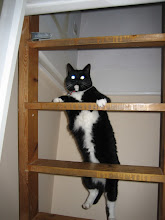Airborne christening party
How do birds learn to fly?
Or, more specifically, how do the aerial nest-builders
manage it?
I have an image of a baby sparrow gradually emerging from a
nest and learning the basics. You know,
fluffing up feathers, eyeing the world and then a few exploratory wing flaps
before a short tentative hop to a lower branch.
But what happens to birds like house martins, facing everything from a dizzy 30ft under the eaves, and no perch nearby?
We’ve been pondering this as we watched the antics of two
families who have built nests high up on the walls of our house. And, like many parents, we wondered when the
young might leave home. And, in this
case, how.
Today we learned much more about such behaviour, and it was
quite a moving and uplifting experience.
At just after 8am, the air to the side of our house became
peppered with house martins flying repeatedly up towards the nest. We could also see the tiny head of the fledging
poking out. This was the day, the
martins had clearly decided, that the young bird would begin to fly.
Round and round they swooped, perhaps a couple of dozen or more of
them. They were clearly demonstrating,
“This is what you do. Come out and join
us.” They kept circling and then, so
quickly that Annie actually missed it, the fledgling tumbled out of the mud
nest and seemingly effortlessly (although it might not have seemed like that to
the young bird) swooped over the garage and was gone.
It was, as Annie said, an airborne christening party.
What reflexes do the birds rely on to decide that this was
the day for flight? And how do they
communicate to act so collaboratively in encouraging the youngster?
It might be corny, but we have so much to learn about, and from, the
world around us.
Labels: Birds, first flight, house martins, natural world, nature

